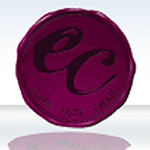 This is my final post on the Epicurean Classic. When I was reading over the class descriptions two classes caught my eye as ones I couldn't miss. It just so happens due to my schizophrenic tastes that they initially seem like diametric opposites. Both of the classes are focused on new cookbooks but on the surface that is where the similarities end, is it true?
This is my final post on the Epicurean Classic. When I was reading over the class descriptions two classes caught my eye as ones I couldn't miss. It just so happens due to my schizophrenic tastes that they initially seem like diametric opposites. Both of the classes are focused on new cookbooks but on the surface that is where the similarities end, is it true?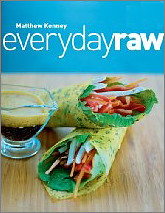
The first is the new cookbook by raw foods chef Matthew Kenney, Everyday Raw. Browsing though the book I noticed that the recipes have incredibly simple ingredient lists. What interests me are the methods of preparation. The finished dishes become much more than just the sum of their parts and yet don't lose the vitality or individuality of the prime ingredients.
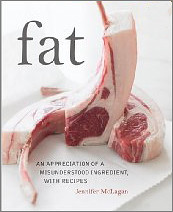 A book dedicated to reviving the use of animal fat may seem like a strange second choice but I couldn't help but be curious about Jennifer McLagan's Fat: An Appreciation of a Misunderstood Ingredient. My son Alex is allergic to dairy and I'm very interested in trying to vary his diet, especially his dietary fats. I like this book's approach: returning to traditional ways where the fat from an animal wasn't wasted but hailed as a valuable ingredient.
A book dedicated to reviving the use of animal fat may seem like a strange second choice but I couldn't help but be curious about Jennifer McLagan's Fat: An Appreciation of a Misunderstood Ingredient. My son Alex is allergic to dairy and I'm very interested in trying to vary his diet, especially his dietary fats. I like this book's approach: returning to traditional ways where the fat from an animal wasn't wasted but hailed as a valuable ingredient.Thursday night, I attended Oryana's raw reception where dishes from Kenney's Everyday Raw book were served. We had raw chili, mango guacamole, watermelon juice, a frozen goji berry souffle and summer squash macaroni and cheese. The chili, which was served warm not hot, was shockingly good. It had the right amount of savoriness and spice. The guacamole, juice and souffle were enjoyable. The creaminess of the cashews in the souffle was excellent and it was nicely balanced with the tart goji berries. The "mac n' cheese" probably shouldn't have been attempted so far ahead of time. The squash "pasta" was too limp and the sauce was watery. I generally like nutritional yeast "cheese" but watered down this one fell flat. It was both unappealing both visually and in taste.
Watermelon juice, raw chili with mango guacamole and frozen goji berry souffle
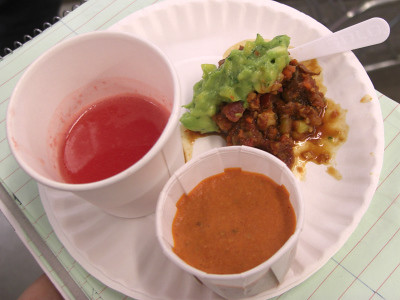 The next morning was Kenney's instructional class. There was a brief description of raw foods and his background as a traditional chef. Then he proceeded to make two raw dishes. First he made the the components for a lasagna (or torta). There was a pistachio pesto, cashew "ricotta" and sun dried tomato sauce. Then he demonstrated how to open a young coconut, something I've been wanting to try. The task required a huge cleaver and didn't look easy but it was fascinating to see the process. It made it at least a bit less intimidating. The young coconut meat went into a blender with maple syrup, coconut butter, and raw cacao powder (raw cocoa). This came together as a chocolate pudding. After the pudding was finished he layered the pesto, "ricotta" and tomato sauce with slices of fresh tomato and very thinly sliced summer squash. Basil garnished the top. The torta was gorgeous! I liked that he was willing to bend the raw food rules for himself and use maple syrup and roasted pistachios. I think the major strength of this style of raw food cooking is that nothing becomes too unidentifiable and there are plenty of flavorful fats from the nuts and coconut ingredients.
The next morning was Kenney's instructional class. There was a brief description of raw foods and his background as a traditional chef. Then he proceeded to make two raw dishes. First he made the the components for a lasagna (or torta). There was a pistachio pesto, cashew "ricotta" and sun dried tomato sauce. Then he demonstrated how to open a young coconut, something I've been wanting to try. The task required a huge cleaver and didn't look easy but it was fascinating to see the process. It made it at least a bit less intimidating. The young coconut meat went into a blender with maple syrup, coconut butter, and raw cacao powder (raw cocoa). This came together as a chocolate pudding. After the pudding was finished he layered the pesto, "ricotta" and tomato sauce with slices of fresh tomato and very thinly sliced summer squash. Basil garnished the top. The torta was gorgeous! I liked that he was willing to bend the raw food rules for himself and use maple syrup and roasted pistachios. I think the major strength of this style of raw food cooking is that nothing becomes too unidentifiable and there are plenty of flavorful fats from the nuts and coconut ingredients.Matthew Kenney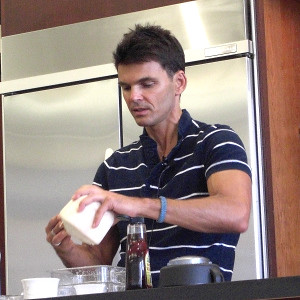 Getting the meat out of a young coconut (note the terrifyingly giant cleaver)
Getting the meat out of a young coconut (note the terrifyingly giant cleaver)
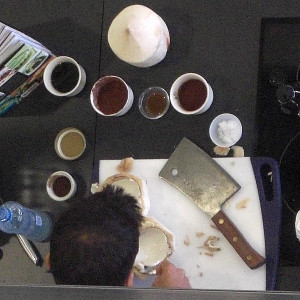 The raw tomato and summer squash torta, with cashew
The raw tomato and summer squash torta, with cashew
"ricotta", sun dried tomato sauce, and pistachio pesto
 Getting the meat out of a young coconut (note the terrifyingly giant cleaver)
Getting the meat out of a young coconut (note the terrifyingly giant cleaver) The raw tomato and summer squash torta, with cashew
The raw tomato and summer squash torta, with cashew"ricotta", sun dried tomato sauce, and pistachio pesto
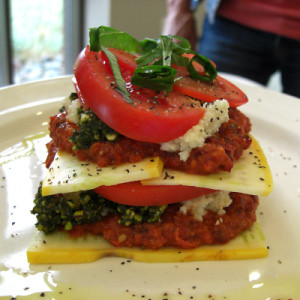 McLagan's fat class was next. She began with a discussion of how animal fats have been unfairly vilified and how the perceived health benefits of vegetable oils aren't holding up to scientific scrutiny. For her first demonstration, she used duck fat to confit garlic cloves. While interesting, I didn't see a huge advantage to this over oven roasting. She followed with talking about the types of pork fat and how to render lard. She used leftover pig skin to make cracklings that were marinaded in salt and star anise. She moved on to beef suet and made biscuits and freshly made butter. This was the best part of her presentation for me. She showed how to take frozen chunks of suet and grate them in a food processor to get a replacement for other fats (IE butter) in baked goods. She made a batch of biscuits with the grated suet that were wonderful! They were delicious, light and fluffy without any beefy taste. I just loved them!!
McLagan's fat class was next. She began with a discussion of how animal fats have been unfairly vilified and how the perceived health benefits of vegetable oils aren't holding up to scientific scrutiny. For her first demonstration, she used duck fat to confit garlic cloves. While interesting, I didn't see a huge advantage to this over oven roasting. She followed with talking about the types of pork fat and how to render lard. She used leftover pig skin to make cracklings that were marinaded in salt and star anise. She moved on to beef suet and made biscuits and freshly made butter. This was the best part of her presentation for me. She showed how to take frozen chunks of suet and grate them in a food processor to get a replacement for other fats (IE butter) in baked goods. She made a batch of biscuits with the grated suet that were wonderful! They were delicious, light and fluffy without any beefy taste. I just loved them!!Jennifer McLagan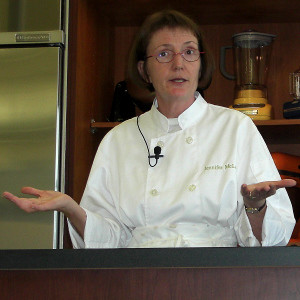 Star anise marinaded pork crackling
Star anise marinaded pork crackling
 Biscuits made with beef suet
Biscuits made with beef suet
 Star anise marinaded pork crackling
Star anise marinaded pork crackling Biscuits made with beef suet
Biscuits made with beef suet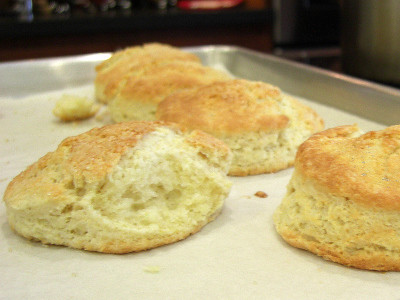 I've already talked to my butcher about getting some beef suet and he says he can get some for me. I've had a hard time finding lard in Southeast Michigan but have heard that it's much easier to find in the Traverse area. Conversely, I've been trying to decide what recipes I should try first in Everyday Raw. What attracts me to both of these cookbooks is that they are making real food. This is not the over-processed, over-salted, over-sweetened, or artificially-sweetened, artificially-colored, nutritionally devoid garbage that comes in a can or box that is shelf stable for years. Instead brilliantly new or old but underused ideas for dealing with food are employed that don't destroy the intrinsic value of the ingredients. I hope I haven't scared off forever all of the vegans with the animal fat or bored the meat eaters with the raw foods. I just feel you have to pick and choose what feels right for you. And never stop trying new things!
I've already talked to my butcher about getting some beef suet and he says he can get some for me. I've had a hard time finding lard in Southeast Michigan but have heard that it's much easier to find in the Traverse area. Conversely, I've been trying to decide what recipes I should try first in Everyday Raw. What attracts me to both of these cookbooks is that they are making real food. This is not the over-processed, over-salted, over-sweetened, or artificially-sweetened, artificially-colored, nutritionally devoid garbage that comes in a can or box that is shelf stable for years. Instead brilliantly new or old but underused ideas for dealing with food are employed that don't destroy the intrinsic value of the ingredients. I hope I haven't scared off forever all of the vegans with the animal fat or bored the meat eaters with the raw foods. I just feel you have to pick and choose what feels right for you. And never stop trying new things!*I want to say thanks again to Foodbuzz for allowing me to represent them at this event and Dianna at Promote Michigan for her help getting me in to the event.
The giveaway!
For those interested, I have an extra signed copy of Matthew Kenney's Everyday Raw to share. Leave a comment on this post or email me at doghillkitchen {at} gmail (dot) com and I'll wait until midnight on Tuesday, September 30th and then pick a random winner.
Other classes and cookbooks from the Epicurean Classic:
Small Plates, Perfect Wines: Creating Little Dishes with Big Flavors
Narlock made a grilled celery dish from the book that was excellent. It was simply grilled celery topped with truffle oil, Parmesan cheese, balsamic vinegar and toasted pine nuts but the flavor combination was outstanding. It's a recipe I'm going to try making soon.
The Paris Neighborhood Cookbook: Danyel Couet's Guide to the City's Ethnic Cuisines
This book has an interesting mix of different ethnic recipes. There is a lot of intriguing spicing and variety. For the demonstration he made a Ras al Hanout blend with roses in it. The author's good looks and accent didn't hurt the presentation either.
660 Curries
This book has an extensive amount of background information in it as well as a huge number of recipes. There is history of ingredients and comparisons of the different regions of India. I loved the short personal stories that come before most of the recipes.
Matthew Kenney's site
Jennifer McLagan's site
